Barrel Room Spotlight | Floodland Brewing

- Eric Griffin
- On January 16, 2024
Up until this point, the Barrel Room Spotlight has exclusively featured brewery programs specializing in malty, high-gravity, oak-aged beers. For this installment, Floodland Brewing breaks the mold. We had the privilege of interviewing founder and brewer Adam Paysse to gain some insight into Floodland’s mixed fermentation portfolio, some of his approaches to culture collection and ingredients, and how he is able to assert his vision through unique, high-quality, bottle-conditioned beers.
The Floodland Standard
Adam Paysse never strived for his vision to be influenced by anybody else. Rather than thinking about Floodland’s approach in relation to other breweries, he instead focuses more on how to make the brewery’s beers better, and how to make Floodland work best in practice and as an employer. Additionally, while he always thinks about—and is insightful about—the goals and overall purpose of owning a brewery, Paysse said he prefers others to be the ones that speak to the results Floodland achieves.
Paysse clearly brings an artistic vision and approach to what he’s doing at Floodland, and many of his series of blends reflect his interest in approaching brewing conceptually. That is to say, viewing beer as a vehicle for expression and making art—a metaphysical lens. For Paysse, it’s when brewing is imbued with these additional levels that it becomes fun. Between the brewing processes and his label art and design, Floodland isn’t just a business, but an ongoing artistic project. His work doesn’t need to appeal to everyone. Instead, he simply wants it to express a point of view.
“It’s easy to get wrapped up in what other people are doing or what other people think, but that doesn’t provide you with much in return.”
The Barrel Room

As is customary with this series, we look first to the barrels. As is also the case with aging high-gravity beers, mixed fermentation recipes need to consider things like barrel types, ingredients, and the integration of the two together. When it comes to casks, they can be treated as ingredients or vessels. Using this spectrum of reference, Floodland tends to veer heavily to the latter.
Paysse explained that Floodland’s team typically seeks out barrels that are older and very neutral, and their barrel maintenance is geared towards minimizing oak extraction. That said, occasionally exceptions are made. For example, the barrels that they use from Big Gin Distillery, based in Seattle. They have a good relationship with head distiller Alex Myers, and they often utilize the spent casks from the barrel-aged version of their dry gin. These barrels lend enormous character to their beers, as well as additional depth and complexity to their portfolio.
The beers brewed at Floodland undergo very slow fermentations, and the micro-oxygenation from the vessel they are in significantly affects how that fermentation progresses. Not only does a barrel or wooden tank affect the fermentation profile of a mixed-culture beer, but the geometry of the vessel also needs to be taken into consideration.
Ingredient Selection
Beer refermented with fruit as a method of preservation is a technique that has been around for a long time. The fruit itself is an integral part of the process, just as much as hops or anything else. For this reason, and in contrast to the other installments in this series, added ingredients to these mixed-fermentation beers (such as fruits and flowers) are not considered adjuncts. In fact, while Paysse added that they aren’t much about anachronisms, he also noted that most of their other botanical beers are similar in that yarrow is used before hops. This speaks to an appreciation of nearly lost brewing history, which has been an elemental component of the Saison revival.
In terms of how these ingredients are selected, whether it be fruit, botanicals, or otherwise, is based largely on things grown locally that the team is particularly excited about. Floodland’s team mostly buys the fruit it uses directly from farmers. Paysse added that the brewery is fortunate to be located in an area full of orchards and vineyards, which also speaks to why they make so many of those types of beers. Floodland’s team has never used purees or extracts, nor do they plan to.
Harvesting
Sourcing good ingredients takes time and work. Typically Paysse starts with the obvious options—fruits with good out-of-hand flavors, grown by people who share similar values to brewery staff. As far as quality goes, it’s about putting in the time to try the product and talk to the farmers.
Networking and relationship-building is a large part of the process. From Paysse’s experience, he believes that the farmers the brewery works with were able to quickly realize that part of the Floodland approach is doing justice to their hard work. That level of respect goes a long way in getting access to good ingredients.
Exploring Cultures
Dregs
An entire separate series could be devoted to on culture collection and nurturing alone. That said, after speaking with Paysse, we’re here to try and condense it down and highlight some of Floodland’s processes.
Much in the same way Floodland doesn’t brew just one base beer, its team doesn’t have just one single house culture that they use. One of the first strains that Paysse brewed with—and one of the main Saison cultures the brewery’s team still uses today—was a collection of propped up dregs from a handful of personal favorite clean Belgian Saisons as well as a single Brett strain isolated from a vintage Fantôme bottle.
Backtracking slightly, dregs refer to the leftover sludgy buildup of yeast and coagulated proteins that settle at the bottom of unfiltered beers. Harvesting, or “pitching,” dregs is fairly common practice in the industry, and has led to the creation of unique and exciting strains to use alongside other regionally varied ambient and wild strains.
Paysse went on to say that he took these “appropriated” strains from bottles and open-fermented them until they began to acidify from some of the bacteria they had picked up. To gather some strains of the aforementioned ambient and wild strains, he repitched small porch coolship ferments and native grape fermentations, as well as a few other methods.
Appropriated Strains
While these earlier strains that Paysse developed were appropriated from various bottles, there hasn’t been any further appropriation of cultures for Floodland beer for seven or eight years now. Currently they limit their use primarily to their own various cultures and will buy yeast occasionally for bottle conditioning. That said, Paysse did have a few notes about propping up dregs from bottles. He went on to say that it just has to be constantly assessed as it goes; continue to grow it up and brew with it and see what happens.
“Appropriating cultures is easy. Managing them over years and keeping them in line without having to reset them from lab isolates is where it gets difficult… and interesting.”
Wort
Looking back at Floodland’s beginning, it was more commonplace for Paysse to make wort just for the purpose of propagating and maintaining a handful of cultures in carboys and kegs. Nowadays, the Floodland team tends to manage strains more by sensory evaluation of barrels. They change how they propagate and harvest them based on their development, and Paysse noted that he’d accepted over time that with oak they are inevitably always going to mingle unless there’s notable strictness about exactly what goes into what barrel. In Floodland’s case, the laissez-faire mentality on this topic has led to some beautifully distinct outcomes.
Maintaining Quality
We wanted to take some time to discuss with Paysse the more prominent things to look out for when it comes to avoiding compromised quality of their beer. He explained that it’s all about sensory analysis; shaping a culture and maintaining it to fit your preferences. There’s far from any concrete set of rules to abide by on what is or isn’t “good.” Paysse used an example of beers containing ethyl acetate. Some mixed culture brewers have been known to enjoy the character imparted by it, while personally for him it is not a favorable quality at any detectable level for their beers.
At Floodland, they tend to make low-phenolic beers with a more subtle fermentation character. That is to say, they try to balance slow ferments with Brett yeast, which presents more citrus and floral character to the profile. Phenols in general can be difficult as they represent a wide range of compounds that encompass everything from favorable to entirely unwanted. While sometimes Floodland will push the boundaries in order to achieve something more funky and Lambic-influenced as a nice change of pace, it’s not typically the goal with the beer they brew.
Floodland beers are known to be soft, fluffy, aromatic and dry. This isn’t by accident. Paysse and the team propagate, harvest, pitch and balance their culture to achieve those goals specifically. According to Paysse it’s really all about what you want your end goal to be—there are so many ways to go about creating good mixed-culture beer.
“I think a brewer’s process is their terroir. If we all brewed the same way or thought there was one “right” or “best” way to do things, then everything would be incredibly boring.”
Balance vs. Control
The concept of balance in beer is pretty relative. In the case of Floodland beers, there is immediately an imbalance inherent to the style that they brew. To elaborate, their beers are very dry, and while all beers are acidic in some capacity, theirs are more acidic than most clean ales and lagers. For context, Paysse used an example from the I’ll Drink to That podcast, an episode with Maggie Harrison from Antica Terra. In it, she discusses the idea of blending blind, in service of “finding the most beautiful thing on the table.” Her focus on subtlety and nuance simultaneously creates wines that are huge and powerful. Contextualizing beauty in this way was something that Paysse noted as being very helpful to him in his own discipline.
Managing Cultures
When it comes to the length of time it takes for culture development, there is no trusting what will happen. For Floodland in particular, Paysse described managing the mixed cultures they work like playing whack-a-mole, often having to adjust what is thrown at it. Adding to this, because Floodland team doesn’t work with a single house culture, they are also having to frequently balance different pitches and barrels to see what should be used for which batch.
Paysse explained that it’s just one of those things where you really can’t let your guard down or everything can suddenly go wrong. It can be stressful at times trying to keep everything acting appropriately, and preventing beers from getting phenolic or too acidic among other things. He noted that in the instances where this does happen, his experience has allowed him to easily be able to rebuild a culture. That said, he always intends to avoid the task itself and the delays that come with it. Fermentation on Floodland’s beers didn’t begin to hit their stride until around their third year; prior to that, there was a lot more hit-or-miss results due to the youth of their cultures.

Methodology
In the world of mixed fermentation beers, there’s little room for the ability to develop formulas. At Floodland this holds true as well. That said, sometimes they do make adjustments to a beer’s grist, hopping or fermentation method in order to allow it to age for longer or shorter periods of time.
While there are certain expectations for aging timelines going into many of the batches Floodland brews, Paysse’s preference has been like many other brewers in this series in wanting to allow the beer to dictate when it’s ready. Where the primary difference with mixed fermentation occurs, however, is in its much slower pace.
At the end of the day, different brewers will use different methods. For Paysse and Floodland, it’s always been about building up a palate for what “ready” is. Based on that, the decision can be made to push barrels to age longer, pull them and package, or blend them younger to achieve certain effects. One final note Paysse made on this topic is that older is absolutely not always going to mean better. All the beers have what he describes as an arc. That is to say, they slowly develop and improve until they ultimately plateau and then begin to fade. The bottle refermentation affects this quite a bit, as the beer is essentially being taken off course and an entirely new fermentation is thrown at it. Often it can be difficult to tell when a beer is on the ascent or descent of this arc.
Letting the Liquid Speak for Itself
This series always looks to highlight specific beers from brewery portfolios first hand. In-depth sensory reviews have helped not only to show examples of information outlined in the Spotlight, but are also able to give readers an idea of what to expect if seeking out these beers on their own.
Paysse was gracious enough to send some bottles for us to review here at PorchDrinking, and we are so thankful for the continued generosity that allows us to include this section with each Barrel Room Spotlight installment.
Death Come Quickly (Harvest 2021)

Death Come Quickly is a blend of wheat Saison fermented in oak and refermented on raw honey. The 2021 harvest blend was created from well-aged mixed culture Saison brewed with raw wheat and malted barley grown in Oregon and Washington. This blend underwent a very slow refermentation on single site, single harvest, raw honey from Cougar Canyon Apiary collected from hives at Buzzard Lake on Sept. 18, 2021. The September 2021harvest consists largely of spotted and diffuse knapweed, as well as other wildflowers blooming in the area at the time. This beer was refermented to condition in the bottle with additional raw honey.
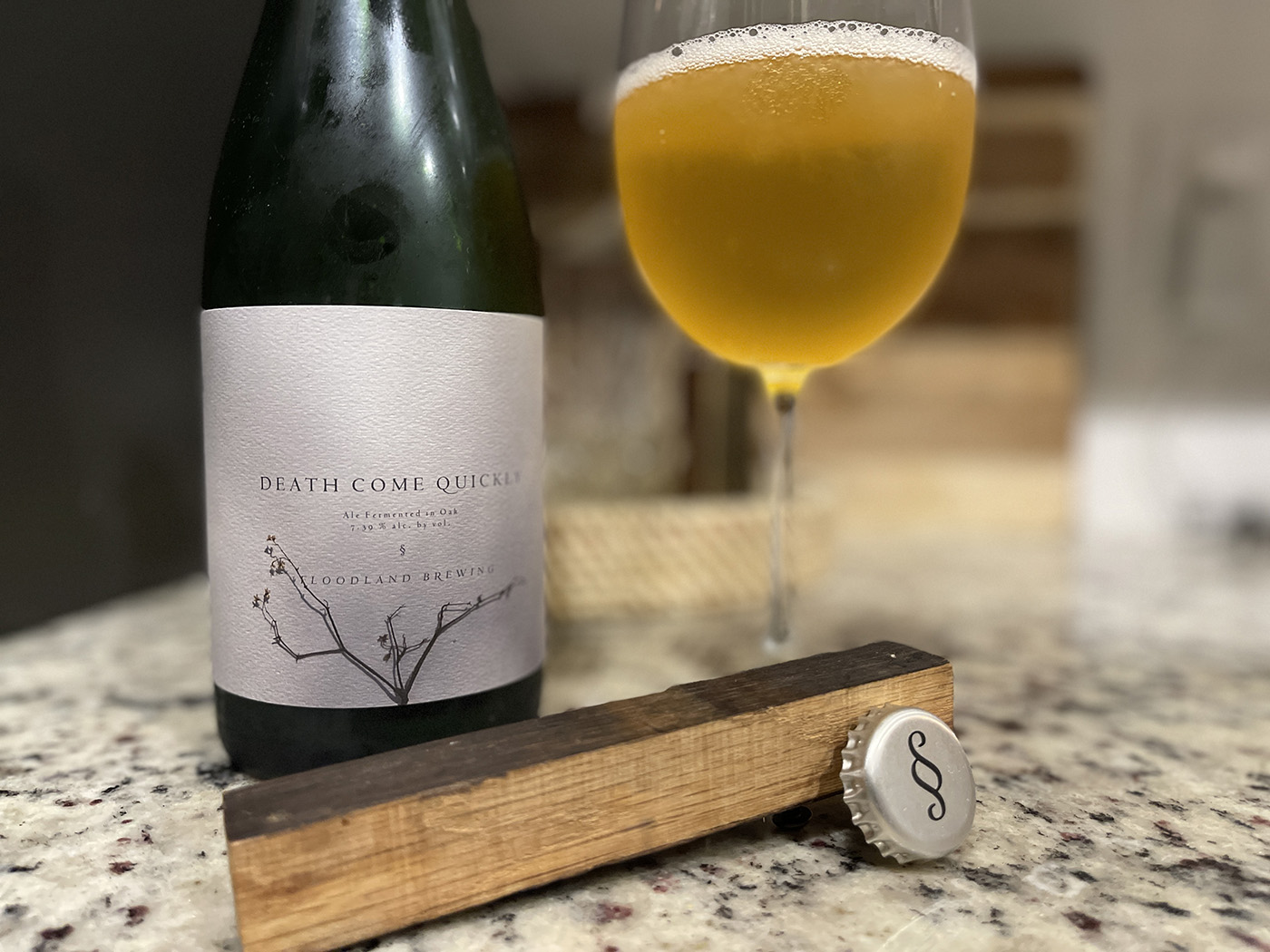
The beer pours with a bright golden coloration. A frothy white carbonation builds above the body, and settles in a thin ring with lazy residual islands that float around the surface.
The nose has a sweetness to it, with rich complexity from the honey making its presence known. Largely characterized by mildly bitter, herbaceous, floral notes, the addition of more musty, woody undertones helps round out the nose perfectly. With time in the glass there’s a huge increase in a sort of organic, floral funk that is really pleasant.
The palate brings many similarities from the nose, which is unlike a lot of the Floodland we’ve had. There is a drying oak, sweet must and floral bitterness. A touch of rustic cheesiness brings with it another added level of complexity.
After about 20 minutes in the glass and seemingly out of nowhere, an abundance of citrus notes come to the forefront of the profile. Bitter lemon peel and a bright expression of orange exude primarily on the nose, with some underlying notes on the palate as well.
Dwellers by the Waysides (2022)
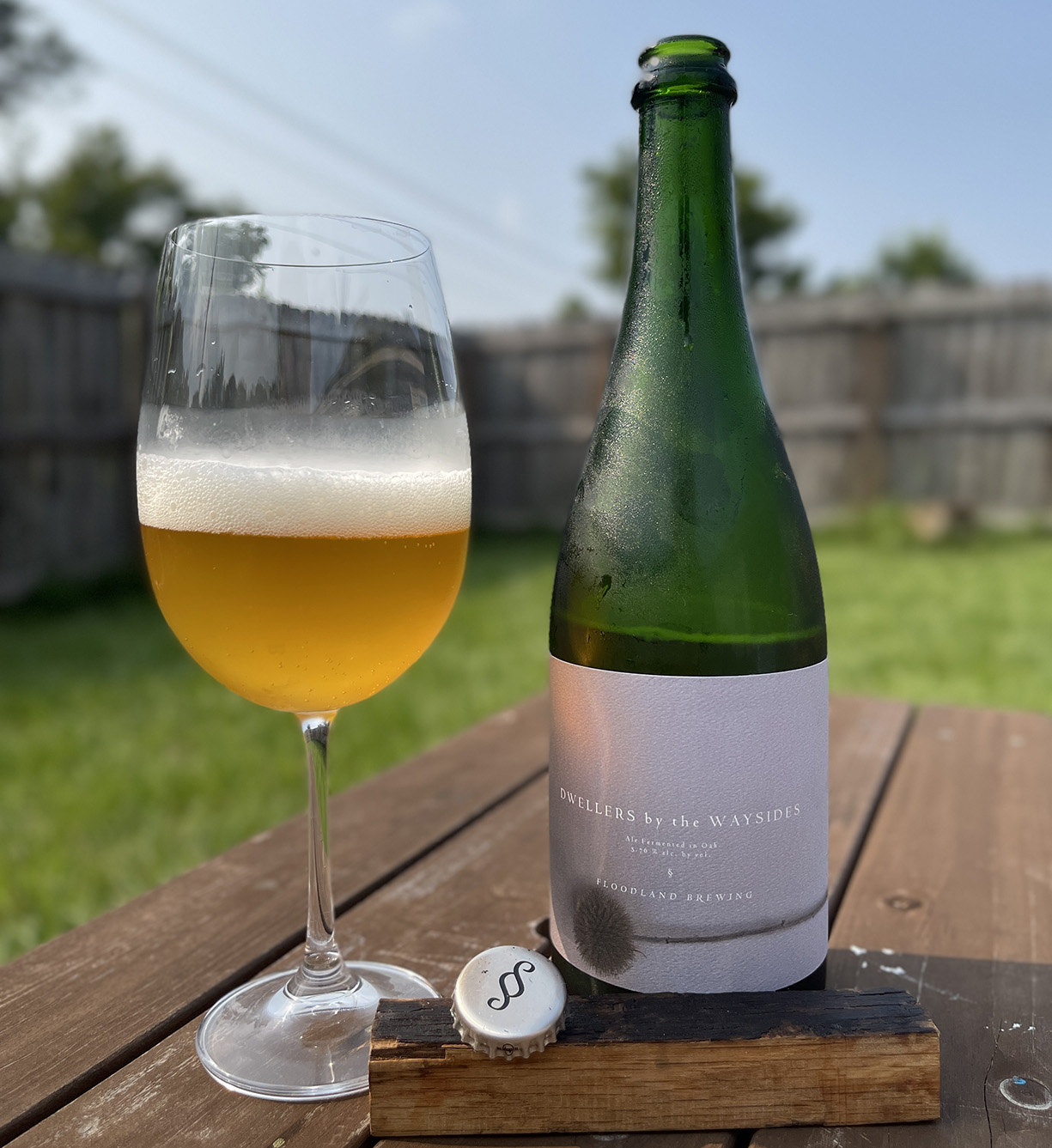
The 2022 iteration of Dwellers by the Waysides is a blend of Saison brewed with raw and malted spelt and malted barley. The beers were open- and barrel-fermented and aged until ready. The blend was macerated with yarrow flower harvested in the mountains surrounding the Methow River. This beer was refermented to condition in the bottle with raw honey from Cougar Canyon Apiary harvested in Chiliwist on Sept. 25, 2021. This most recent iteration was bottled on July 14, 2022.
This beer has a beautiful golden hue, with soft, frothy white carbonation that rises to a finger and a half above the body of the beer.
The nose is herbaceous, lemony and mildly spiced. The aromas are akin to gin botanicals—hints of cardamom, coriander and juniper. There’s a bright, woody funk on the finish.
The palate is dry and herbaceous, with an earthy pungency, bright citrus and an abundance of mildly bitter floral notes. The bouquet of earthy, floral, and citrusy notes are amazing.
There is a light, crushable feel to this beer; the carbonation is soft and seltzery. There’s a tannic dryness on the tail that finishes lightly bitter. Undoubtedly bright and clean. An exceptional experience.
Filaree (2022)

This beer was created using 2021 harvest Santa Rosa and Elephant Heart plums grown organically in Okanogan, Washington by JC and Amber Kaufmann at Filaree Fruit. The plums were refermented with barrel-aged and fermented-spelt Saison. This beer is an attempt to showcase the fruit grown by the Kaufmann family at Filaree. Refermented to condition in the bottle with honey from Cougar Canyon Apiary harvested on Sept. 25, 2021 in Chiliwist.
Filaree pours a clouded ruby, with about three fingers of frothy foam that bubbles over the brim of the glass.
The nose on this is fantastic; loaded with plum skin. The musty, floral undertones bring notes of dandelion, fresh herbs and hints of gin botanicals that balance the fruit.
The palate again is a beautiful feature of plum; tart, acidic and tannic. There are additional layers to the flavor profile featuring lemon zest, underripe red berries, and hints of vanilla. A prominent yeast character also incorporates a noticeable yet restrained musty funk.
This saison is bright, dry and tart, with great tannin from the plum skin and a balanced acidity throughout. The mid-palate hits with a touch of pucker, but effervescence from the carbonation cuts it at the perfect time.
In the Meadows (2023)
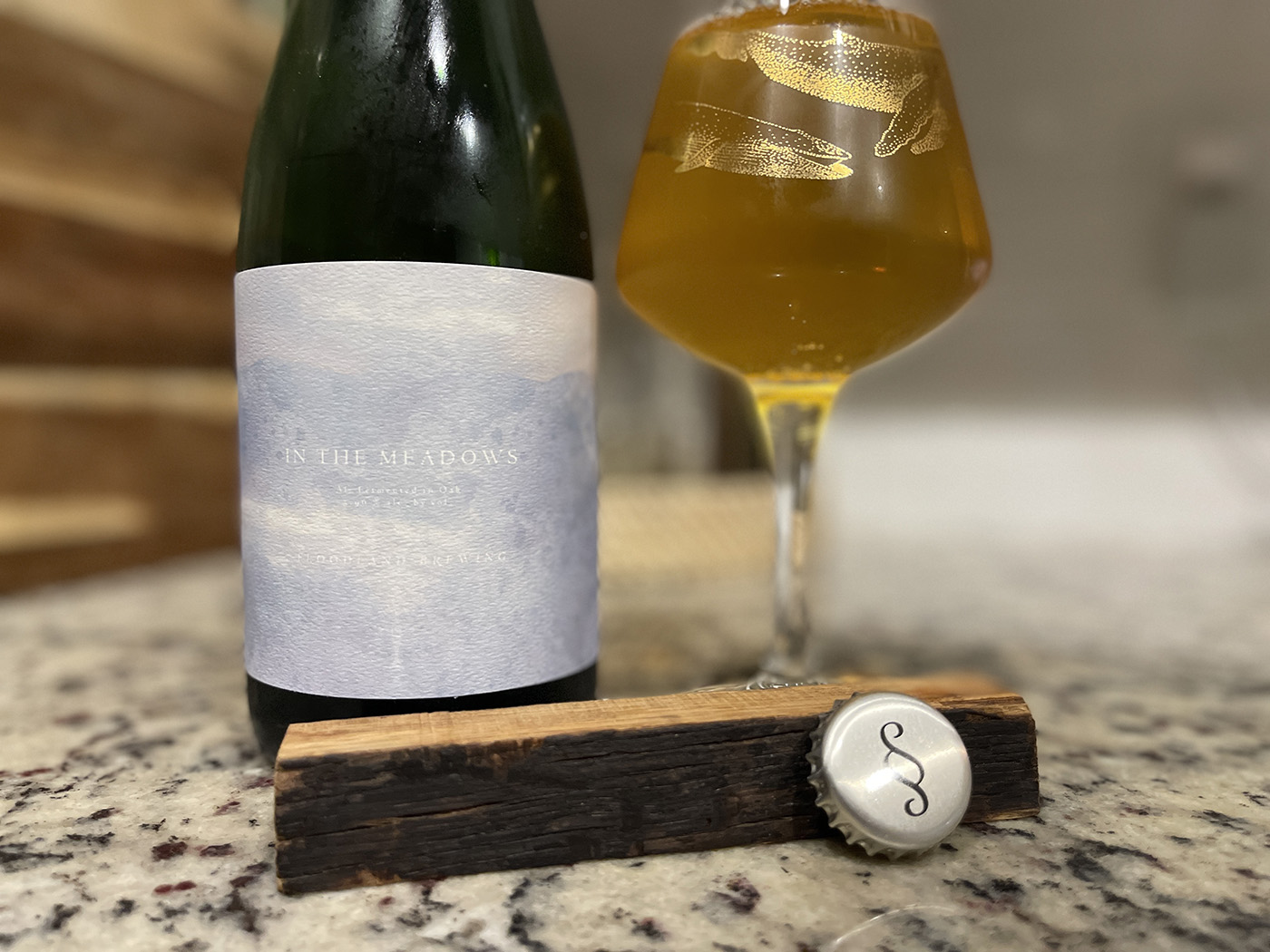
In the Meadows is a blended wheat Saison. The 2023 blend was created from two distinct beers. The first was brewed with wheat and spelt, hopped with flower grown in Germany and New Zealand, open-fermented and then aged in neutral oak. The other was brewed with wheat and oats, hopped with flower from Washington and New Zealand, and barrel-fermented in neutral oak.
There’s a crystal clear golden coloration to the beer. Carbonation bubbles up into about a finger of head that quickly recedes. After a few minutes, hardly any carbonation is noticeable without agitating the glass.
We recommend giving this one a couple minutes to open up. With time, a subtle honey sweetness greets the nose. Following closely are notes of stone fruit, wildflowers, lemon zest, fresh-cut grass and damp, musty oak.
The palate is dry and restrained, but with time we can pick out a great bouquet of flavors. It favors the more floral character, with a bit of bittering grapefruit, peach skin and oak lactones.
The mouthfeel is phenomenal; dry, with a soft effervescence and restrained tartness. A tightly cohesive Saison.
MMXXI Flowers of the Field (2021)

This beer is a native refermentation of 2021 Harvest Pinot Noir and Chardonnay grapes. The 2021 harvest beer was made through an entirely native fermentation of Chardonnay grapes from French Creek Vineyard in the Yakima River Valley and Pinot Noir grapes from Johan Vineyards in the Van Duzer Corridor. This beer consists of a blend of open and barrel-fermented Saison. Refermented to condition in the bottle with raw honey from Cougar Canyon Apiary. Bottled on June 2, 2022.
Similar to Filaree, Flowers pours with a beautiful ruby coloration. A thin frothy carbonation quickly recedes into the seltzery body of the beer.
The nose opens up with grape must, plum skins and a mildly cheesy funk. There’s an underlying sweetness of red berries, but a clear predominance of bright acid and present funk.
The palate shows a lot more restraint than the nose. Dry and oak-heavy, with a touch of pucker and grape skins on the finish. The Pinot Noir grapes really feature as we continue to sip, but noticeably softer.
The mouthfeel is dry, tannic and seltzery. Even with bubbly carbonation and tannic dryness it has a soft approach, and finishes with a touch of warmth. The barrel fermentation qualities really come on strong, increasingly so with time in the glass.
Neither/Nor (2022)
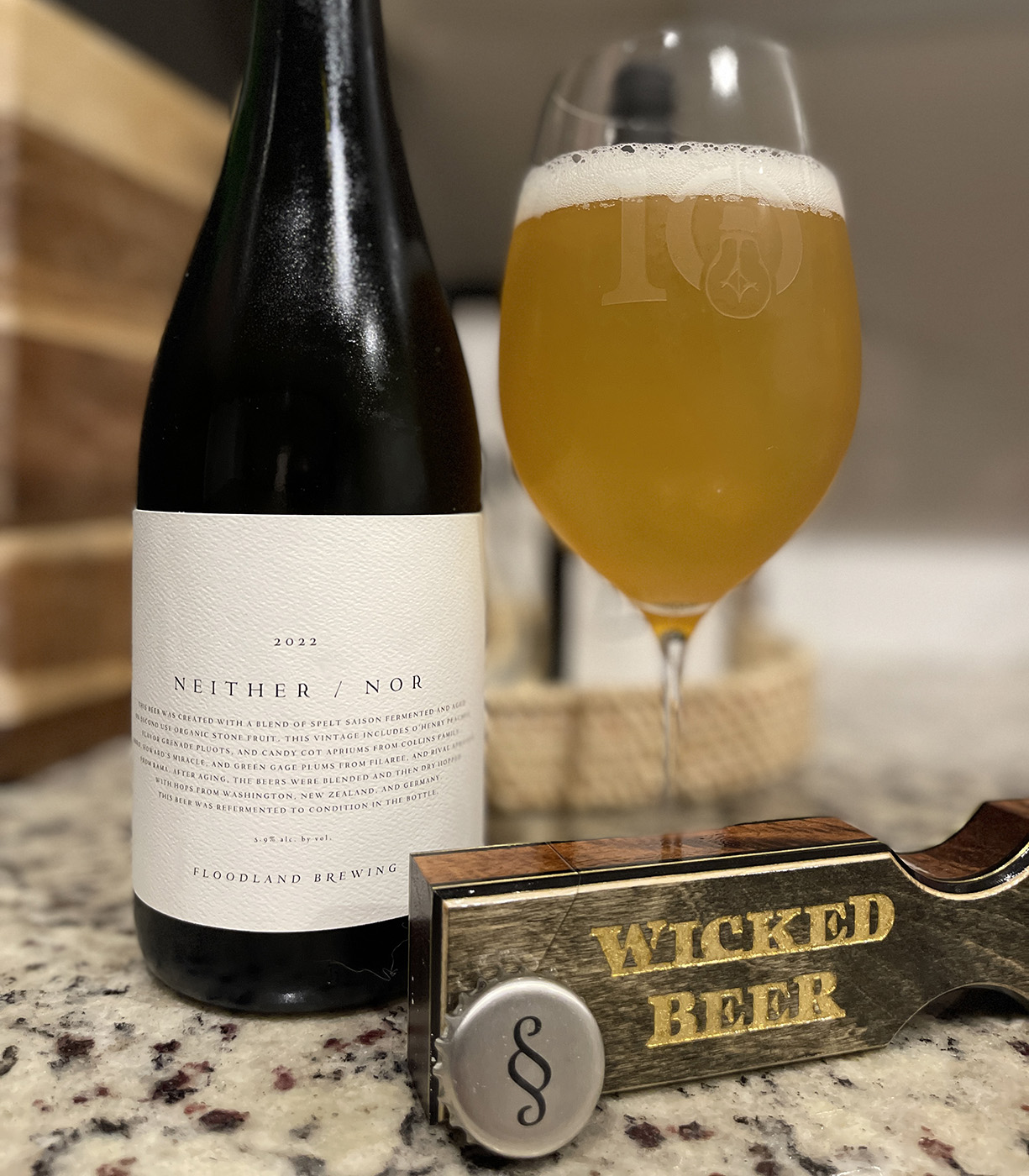
This beer was created with a blend of spelt Saison fermented and aged on second-use organic stone fruit. This vintage includes O’Henry peaches, Flavor Grenade pluots, and Candy Cot apriums from Collins Family. Shiro, Howard’s Miracle, and Green Gage plums came from Filaree, and the Rival apricots from RAMA. After aging, the beers were blended and then dry hopped with hops from Washington, New Zealand and Germany. Refermented to condition in the bottle.
The pour on Neither/Nor has a hazy golden coloration. Light, fluffy white carbonation rises a good two fingers above the body of the beer before settling back down to about a half inch of head.
The nose is bright and full of fruit, characterizing predominantly lemon zest, ripe peaches, fresh-cut lumber and a touch of damp mustiness and floral esters.
The palate leads with oaky dryness, opening up for a tart, tannic follow-through of stone fruit. There’s a mildly bittering, floral hop component as well, complemented by undertones of lemony brightness. The finish brings subtle notes of hay and white wine.
This Saison boasts Floodland’s signature soft mouthfeel, with a seltzery carbonation and a great balance of acid and bitterness. The finish is bright and tart, leaving behind a noticeably drying tannin.

Looking Toward the Future
Dialing In
Floodland beers have evolved over the years. That said, developments over time that may have appeared subtle to anyone drinking them have likely been dramatic shifts to Paysse and his team. They’ve also amassed a set of more neutral barrels that have allowed them to be able to age the beers for longer with less oak impact. This has created some flexibility and the ability to make beers that maintain the fresh, soft and spritzy profile Floodland is known for.
Paysse refers to the beers they make as third-wave Saison, with the subset of the style intentionally less phenolic, less malty and drier than lambic. For that reason, he feels that it helps them drink at a much younger age; considerably softer and more pleasant. He feels they are dialed into that now more than ever.
Rising Costs
As Floodland looks ahead and plans for the future, there is still so much to keep in sight. Costs have risen dramatically, and so many have felt the impact of inflation. Glass in particular has been a notable fluctuation for the brewery, soaring to over $3 per bottle for something that two years ago would have been less than $1. Having to plan and purchase so far out has led to the risk of under-ordering and having to deal with the shortage, or over-ordering and needing to deal with associated storage charges.
Ultimately, Floodland’s team has always paid what they needed to for the best ingredients. Not only that, but in a conscious effort to make Floodland a healthy and supportive workplace, Paysse always pays employees a living wage. Just like so many other industries, craft beer also sees its fair share of worker exploitation. It’s not worth the alienation of their customer base or employees through raising prices just to make ends meet. Cost fluctuation and inflation is part of running a business, and Paysse recognizes the importance of maintaining a work environment that can always comfortably support this as well as those that work with him.
Availability
A common question that Paysse gets is in regards to a retail presence, but right now, he has no plans for this. While Floodland isn’t looking to expand at this time, Paysse hopes that down the line the brewery will have the ability to ship out of state. And even without a taproom space on the horizon, there is still so much to look forward to from this small Seattle operation. Paysse is setting a new standard in the Saison revival, and anyone who hasn’t already should really start paying attention to this mixed fermentation powerhouse in Washington.
Related Posts
Elysian Brewing Company | Superfuzz Blood Orange Pale... August 12, 2014 | Katelyn Pelak
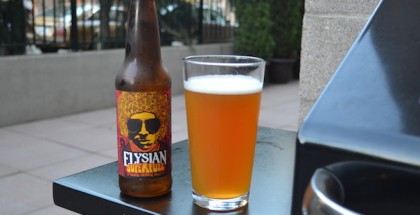
Odell Brewing | Elephunk Imperial Wild IPA... February 1, 2017 | Jared Hardy

Fort George Brewery | City of Dreams October 3, 2018 | Rachyl Fojtik

Propolis Brewing | Spruce Golden Saison August 24, 2017 | Katelyn Pelak





Submit a Comment